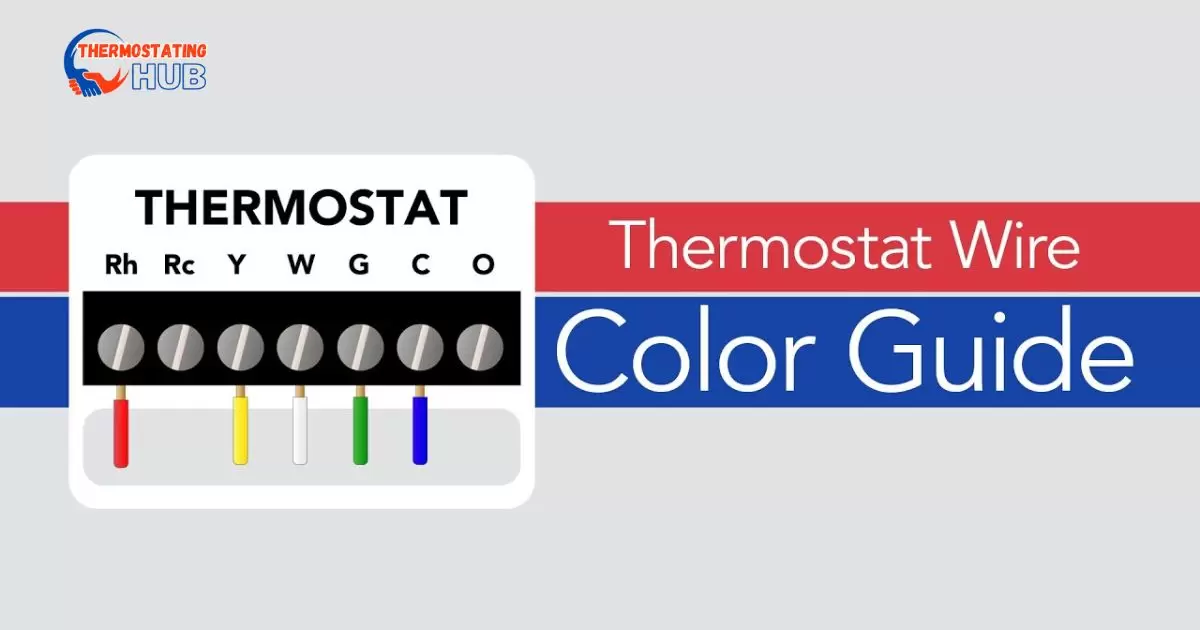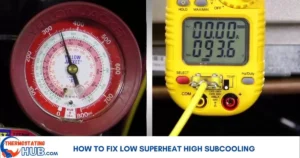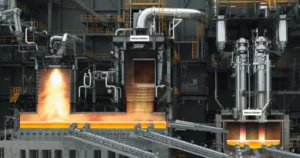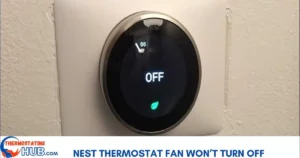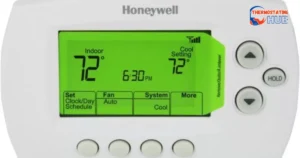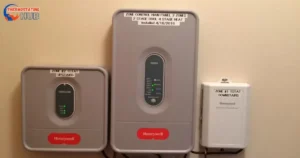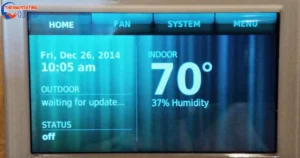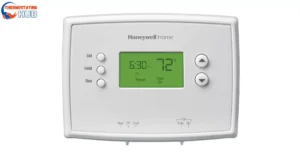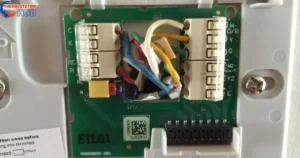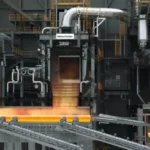The thermostat wiring color code may seem like a puzzle, but tension not!
In this complete guide, we’ll unravel the mysteries of thermostat wiring, making it easy to understand. The good news is there are solutions at your fingertips, ensuring a smooth and hassle-free experience in setting up your thermostat.
Let’s dive into the world of thermostat wiring and make the process a breeze.
Chart for Thermostat Wiring Code, Designation and Function
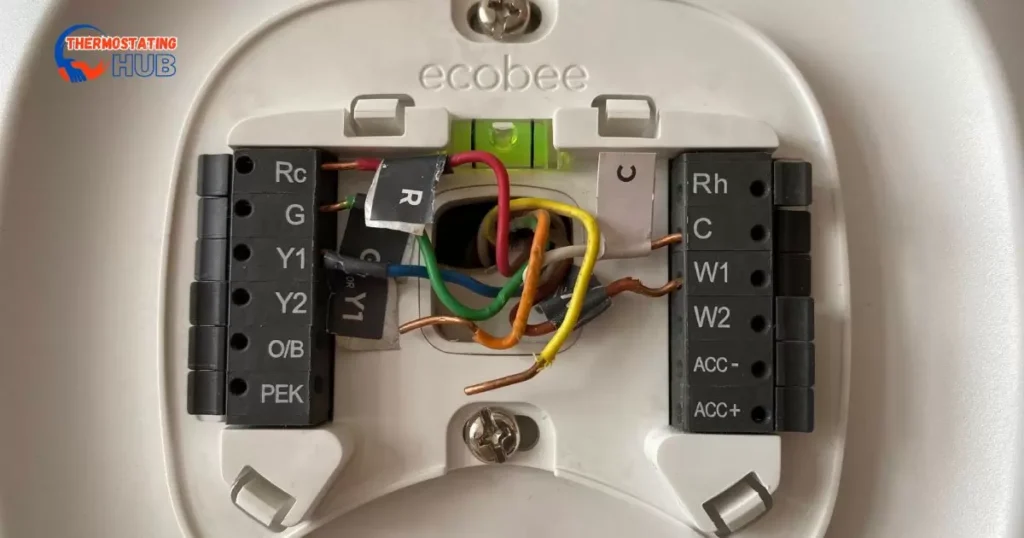
Red wire
The red wire can either R, Rc or Rh. let’s look at what each of these wires really is below:
The red wire in your home’s electrical system is like a messenger that carries power to different parts of your house. It’s like the energy highway, making sure electricity gets where it needs to go.
When you see a red wire, think of it as the conductor that helps your lights shine bright, your appliances work, and your home stay powered up. It’s a key player in keeping things running smoothly!
Blue Wire
This wire, known as the C wire, is like a steady stream of power (24 volts) for the thermostat. It helps the thermostat work well. Not every thermostat needs a C wire, but it’s often found in programmable thermostats, especially the ones that connect to Wi-Fi.
Green Wire
The green wire in your electrical system is like a nature-friendly helper. It usually connects to the fan in your HVAC (heating, ventilation, and air conditioning) system. When your thermostat tells your HVAC system it’s time to cool things down, the green wire gets to work, making sure the fan starts blowing refreshing air. It’s like the green wire is giving your home a breath of fresh air, making it cooler and more comfortable. So, when you see the green wire, think of it as the cool breeze maker.
Orange Wire
The orange wire in your system plays a special role. It’s like a messenger that carries signals between your thermostat and your heating or cooling equipment. Think of it as a helpful conductor making sure your home stays comfy. So, if you see an orange wire, it’s doing an important job in keeping your temperature just the way you like it!
Yellow Wire
The yellow wire in your HVAC system plays a special role. It usually connects to your air conditioner’s compressor. When the thermostat tells your AC it’s time to cool things down, the yellow wire carries that message to the compressor, making sure it kicks into action. So, think of the yellow wire as the messenger that tells your AC to start cooling when you want it to.
Light Blue
Light Blue is a color that’s calm and gentle, like the sky on a sunny day. It’s not too dark, and it’s not too bright; it’s just right in the middle. When you see something in light blue, it often gives a feeling of peace and tranquility. It’s a color that can be soothing and easy on the eyes. Whether it’s the color of your favorite shirt or the walls in a room, light blue adds a touch of serenity to the world around you.
White Wire
W: The W wire, also known as the W terminal, is in charge of making things warm. When the thermostat wants to heat up the place, the W wire tells the furnace or boiler to begin making things cozy.
Black Wire
The black wire is one of the colored wires used in electrical systems. It plays a special role in helping electricity flow from one place to another. Think of it like a pathway that guides electrical energy. When you see a black wire, it usually means it’s carrying power to something, like a light or an appliance. So, in simple terms, the black wire is like a conductor that helps make sure your electrical devices get the energy they need to work.
Brown Wire
The brown wire is a special part of your electrical system. It’s like a messenger that carries signals between your thermostat and HVAC system. Just like each wire has its job, the brown one plays a crucial role in making sure your heating and cooling equipment understands what your thermostat wants.
So, when you see that brown wire, know that it’s helping keep your home comfortable by delivering important messages between your thermostat and HVAC system.
Read also: Furnace Shuts Off After 30 Seconds [Fixed]
No Fixed Color Wires
ACC Wire: The ACC wire isn’t a usual label for thermostat wires. But, if you have it, you can use it to connect extra things like dehumidifiers or humidifiers.
S, S1, S2 Wires: These wires are often used for things like outdoor temperature sensors or system status lights.
L Terminal: The L terminal is meant for indicator lights on the thermostat. These lights might come on when you use auxiliary or emergency heat, or if there’s a general problem with your system.
K: The K wire is like a special helper for your thermostat. It’s called a Honeywell Wire Saver Module. Basically, it takes the Y and G terminals and puts them together to create a single K wire. This K wire then connects to the K terminal. This is handy for systems that don’t have a C wire but need one for the thermostat to work properly.
5 wire thermostat wiring color code
Devices that use a wiring system with five wires include:
- Two-stage furnace
- First stage furnace and first stage air conditioner
- First stage heat pump system
| System Type | G (Green) | Y (Yellow) | C (Blue) | R (Red) | W (White) | W2/Aux (Brown) | O/B (Orange) |
| 2nd Stage Furnace | Yes | Not needed | Yes | Yes | Yes | Yes | Not needed |
| 1st Stage Furnace and AC | Yes | Yes | Yes | Yes | Yes | Not needed | Not needed |
| 1st Stage Heat Pump System | Yes | Yes | Yes | Yes | Not needed | Not needed | Ye |
4 Wire thermostat wiring color code
The 4 wiring code might be used by these systems:
- Initial Heating Unit
| Type of system | G (Green) | R (Red) | W (White) | C (Blue) |
| Initial Heating Unit | Yes | Yes | Yes | Yes |
6 wire thermostat wiring color code
Devices with a 6-wire setup might have the following wiring code.
- Heat the furnace to the third stage
- Use the second stage of the furnace along with the first stage of the air conditioner
- Utilize the first stage of the furnace alongside the second stage of the air conditioner
- Operate the first stage of the heat pump with auxiliary heat
- Activate the second stage of the heat pump
- Use a single stage of the heat pump with one stage of heat
| Type of System | Y (Yellow) | Y2 | G (Green) | O/B (Orange) | R (Red) | W1 (White) | W2/Aux (Brown) | C (Blue) | W3/E |
| Heat the furnace to the third stage | Yes | Yes | Yes | Yes | Yes | Yes | Yes | – | – |
| Use the second stage of the furnace along with the first stage of the air conditioner | Yes | – | Yes | – | Yes | Yes | Yes | Yes | – |
| Utilize the first stage of the furnace alongside the second stage of the air conditioner | Yes | Yes | Yes | – | Yes | Yes | – | Yes | – |
| Operate the first stage of the heat pump with auxiliary heat | Yes | – | Yes | Yes | Yes | – | Yes | Yes | – |
| Activate the second stage of the heat pump | Yes | Yes | Yes | Yes | – | – | – | Yes | – |
| Use a single stage of the heat pump with one stage of heat | Yes | – | Yes | Yes | Yes | Yes | – | Yes |
7 wire thermostat wiring color code
- Heat Pump with Auxiliary Heat (2nd Stage)
- Heat Pump with 1-Stage Heating (2nd Stage)
- Heat Pump with 2-Stage Heating, 1-Stage Cooling (1st Stage)
| Heat Pump with Auxiliary Heat (2nd Stage) | Heat Pump with 1-Stage Heating (2nd Stage) | Heat Pump with 2-Stage Heating, 1-Stage Cooling (1st Stage) | |
| Y | Yes | Yes | Yes |
| Y2 | Yes | Yes | Not needed |
| W1 | Not needed | Not needed | Yes |
| Aux/W2 | Yes | Yes | Yes |
| C | Yes | Yes | Yes |
| R | Yes | Yes | Yes |
| G | Yes | Yes | Yes |
| O/B | Yes | Yes | Yes |
Pros And Cons Of Thermostat Wiring Color Code:
Pros:
Easy Identification: Color-coded wires make it simple to recognize and connect the right components.
Reduced Errors: Helps in minimizing mistakes during installation, reducing the risk of errors.
Cons :
Inconsistency: Not all systems follow the same color code, leading to confusion in some cases.
Limited Flexibility: Some systems may have unique requirements not covered by the standard color code.
Features Of Thermostat Wiring Color Code
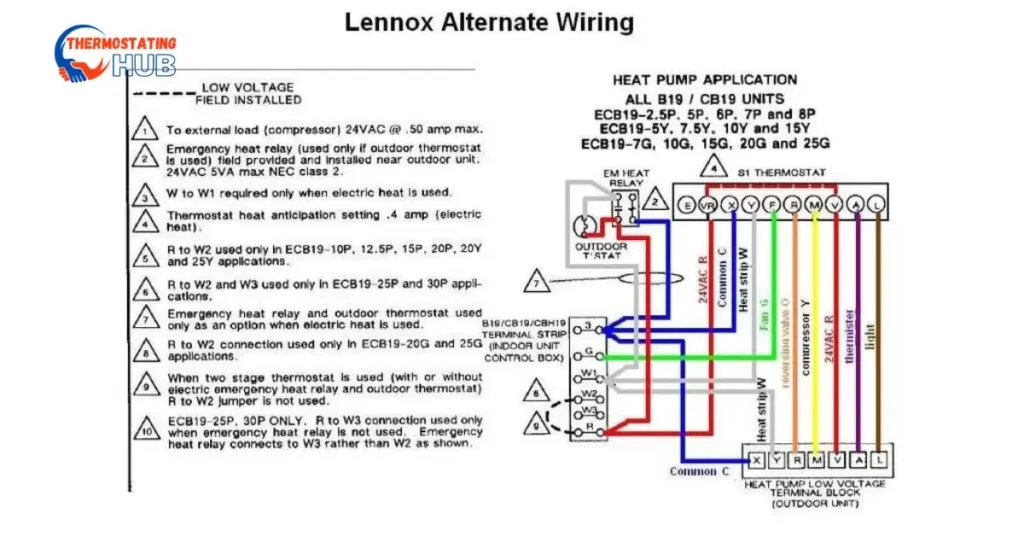
Thermostat Wiring Color Code is like a helpful guide for connecting different wires in your heating and cooling system. Each wire has its own color, making it easier to know where it should go. This system helps people set up their thermostats correctly and avoids mix-ups. It’s like having a color map for your wires, ensuring a smooth and problem-free connection.
Following the Thermostat Wiring Color Code is a simple way to make sure everything works the way it’s supposed to in your HVAC system.
Answers To Key Questions
What color wires go to what on a thermostat?
Generally, thermostat wires are color-coded for easy identification.
Commonly, the colors are red for power, white for heat, yellow for cooling, and green for the fan.
What are the 7 wires on a thermostat?
Thermostats typically have seven wires, each serving a specific function.
Common colors include red (power), white (heat), yellow (cooling), green (fan), blue (common), and additional wires for features like C (common) or W2 (second stage of heat).
What are the 5 thermostat wires?
The basic thermostat wires are usually five in number.
Commonly, they include red (power), white (heat), yellow (cooling), green (fan), and a common wire (often blue).
What are the 4 wires on a thermostat?
Some systems may use a simpler setup with four wires.
These commonly include red (power), white (heat), yellow (cooling), and green (fan).
How do I know which wires go where on a thermostat?
Refer to the thermostat’s manual for guidance, as it typically provides a wiring diagram.
Identify the labeled terminals on both the thermostat and HVAC system, matching each wire to its designated terminal.
What happens if you wire the thermostat wrong?
Incorrect wiring can lead to malfunctions in your HVAC system.
It might cause the heating or cooling to not work properly, or even damage the thermostat, HVAC equipment, or other electrical components.
Following the correct wiring ensures safe and efficient operation.
Final thoughts
Understanding the Thermostat Wiring Color Code is essential for hassle-free HVAC system operation. This complete guide simplifies the process, ensuring that you connect your thermostat correctly and avoid potential issues.
Remember, the colors signify specific functions, and following this code guarantees compatibility between your thermostat and HVAC system. The good news is there are solutions at your fingertips – armed with this knowledge, you can confidently wire your thermostat, enhancing efficiency and preventing malfunctions. With the right color-coded connections, you’ll have better control over your indoor climate, making your home comfortable and energy-efficient.
Embrace the simplicity of the Thermostat Wiring Color Code and enjoy a seamlessly functioning heating and cooling system.

I’m James Wilson, your HVAC maestro from “Thermostating Hub.” Elevate your comfort with my expertise in heating, ventilation, and air conditioning. Let’s transform your space into a haven of perfect temperatures, tackling HVAC issues with precision and enthusiasm.
